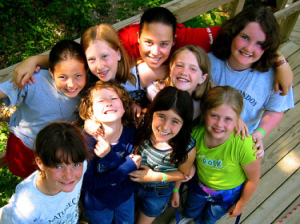When our kids get angry, it pushes buttons for most of us. We’re not perfect, but we try to be loving parents. Why is our child lashing out like this?
Many parents send an angry child to her room to “calm down.” After all, what else can we do? We certainly can’t reason with her when she’s furious. It’s no time to teach lessons or ask for an apology. She needs to calm down.
If we send him to his room, he will indeed calm down, eventually. He’ll also have gotten a clear message that his anger is unacceptable, and that he’s on his own when it comes to managing his big scary feelings–we don’t know how to help him. He won’t have worked through whatever led to his anger. Instead, he’ll have stuffed the anger, so it’s no longer under conscious control, and will burst out again soon. No wonder so many of us develop anger-management issues, whether that means we yell at our kids, throw tantrums with our spouse, or overeat to avoid acknowledging angry feelings.
What can we do instead? We can help our kids learn to manage their anger responsibly. That begins with accepting anger — without acting on it.
This is one of the most critical tasks of childhood–learning to tolerate the wounds of everyday life without moving into reactive anger. People who can do this are able to resolve challenges more constructively. We call them emotionally intelligent.
Kids learn emotional intelligence when we teach them that all their feelings are okay, but it’s their job to control their actions. How?
When your child gets angry:
1. Take a deep breath. Remind yourself that there is no emergency. Keep yourself from moving into fight or flight. This will help calm your child, and model emotional regulation.
2. Remind yourself that tantrums are nature’s way of helping small people let off steam. Their brains are still developing and they don’t yet have the neural pathways to control themselves as we do. (And please note that we don’t always regulate our anger very well, even as adults!)
The best way to help children develop those neural pathways is to offer empathy, while they’re angry and at other times. It’s ok–good, actually–for your child to express those tangled, angry, hurt feelings. After we support kids through a tantrum, they feel closer to us and more trusting. They feel less wound-up inside, so they can be more emotionally generous. They aren’t as rigid and demanding.
3. Remember that anger comes from our “fight, flight or freeze” response. That means it’s a defense against threat. Occasionally that threat is outside us, for instance, when a big brother knocks down a block tower. But usually it isn’t. We see threats outside us because we’re carrying around old stuffed emotions like hurt, fear or sadness. Whatever’s happening in the moment triggers those old feelings, and we go into fight mode to try to stuff them down again.
Losses and disappointments can feel like the end of the world to a child, and kids will do anything to fend off these intolerable feelings, so they cry and rage and lash out. If they feel safe expressing their anger, and we meet that anger with compassion, their anger will begin to melt. That’s when they can access the more upsetting feelings underneath.
So while we accept our child’s anger, it isn’t the anger that is healing. It’s the expression of the tears and fears beneath the anger that washes out the hurt and sadness and makes the anger vanish, because it’s no longer necessary as a defense.
4. Don’t talk except to empathize and reassure her that she’s safe. Don’t try to teach, reason or explain. When she’s awash in adrenaline and other fight or flight reactions is not the time to explain why she can’t have what she wants, or get her to admit that she actually loves her little sister. Just acknowledge how upset she is: “You are so upset about this…I’m sorry it’s so hard.”
5. Set whatever limits are necessary to keep everyone safe, while acknowledging the anger and staying compassionate. “You’re so mad! You can be as mad as you want, but hitting is not ok, no matter how upset you are. You can stomp to show me how mad you are, but I won’t let you hit me.”
6. Set limits on actions only, not on feelings. The more compassionate you can be, the more likely your child will find his way to the tears and fears under the anger: “Oh, Sweetie, I’m sorry this is so hard…You’re saying I never understand you…that must feel so terrible and lonely.” You don’t have to agree or argue. Just acknowledge his truth in the moment.Once he feels heard, his truth will shift.
7. Keep yourself safe. Kids often benefit from pushing against us, so if you can tolerate it and stay compassionate, that’s fine to allow. But if your child is hitting you, move away. If she pursues you, hold her wrist and say “I don’t think I want that angry fist so close to me. I see how angry you are. You can hit the pillow I’m holding, or push against my hands, but I won’t let you hurt me.” Kids don’t really want to hurt us — it scares them and makes them feel guilty. Most of the time, when we move into compassion and they feel heard, kids stop hitting us and start crying.
8. Stay as close as you can. Your child needs an accepting witness who loves him even when he’s angry. If you need to move away to stay safe, tell him “I won’t let you hurt me, so I’m moving back a bit, but I am right here. Whenever you’re ready for a hug, I’m right here.” If he yells at you to “Go away!” say “You’re telling me to go away, so I am moving back a step, ok? I won’t leave you alone with these scary feelings, but I will move back.”
9. Don’t try to evaluate whether he’s over-reacting. Of course he’s over-reacting! But remember that children experience daily hurts and fears that they can’t verbalize and that we don’t even notice. They store them up and then look for an opportunity to “discharge” them. So if your kid has a meltdown over the blue cup and you really can’t go right now to get the red cup out of the car, it’s ok to just lovingly welcome his meltdown. Most of the time, it wasn’t about the blue cup, or whatever he’s demanding. When children get whiny and impossible to please, they usually just need to cry.
10. Acknowledging her anger will help her calm down a bit. Then help her get under the anger by softening yourself. If you can really feel compassion for this struggling young person, she’ll feel it and respond. Don’t analyze, just empathize. “You really wanted that; I’m so sorry, Sweetie.” Once you recognize the feelings under the anger, she will probably pause and stop lashing out. You’ll see some vulnerability or even tears. You can help her surface those feelings by focusing again–repeatedly–on the original trigger: “I’m so sorry you can’t have the _____ you want, Sweetie. I’m sorry this is so hard.” When our loving compassion meets her wound, that’s when she collapses into our arms for a good cry. And all those upset feelings evaporate.
11. AFTER he’s calmed down, you can talk. Don’t start by lecturing. Tell a story to help him put this big wave of emotion in context. “Those were some big feelings…everyone needs to cry sometimes…You wanted….I said no…You were very disappointed…You got so angry….Under the anger, you were so sad and disappointed….Thank you for showing me how you felt….” If he just wants to change the subject, let him. You can circle back to bring closure later in the day or at bedtime, while you’re snuggling.
12. What about teaching? You don’t have to do as much as you think. Your child knows what she did was wrong. It was those big feelings that made her feel like it was an emergency, and necessary to break the rule. By helping her with the emotions, you’re making a repeat infraction less likely.
Wait until after the emotional closure, and then keep it simple. Recognize that part of her wants to make a better choice next time, and align with that part. Be sure to give her a chance to practice a better solution to her problem. “When we get really angry, like you were angry at your sister, we forget how much we love the other person. They look like they’re our enemy. Right? You were so very mad at her. We all get mad like that and when we are very mad, we feel like hitting. But if we do, later we’re sorry that we hurt someone. We wish we could have used our words. What could you have said or done, instead of hitting?”
Accepting emotions like this is the beginning of resilience. Gradually, your child will internalize the ability to weather disappointment, and learn that while he can’t always get what he wants, he can always get something better — someone who loves and accepts all of him, including the yucky parts like rage and disappointment. He’ll have learned that emotions aren’t dangerous–they can be tolerated without acting on them, and they pass. Gradually, he’ll learn to to verbalize his feelings even when he’s furious.
You’ll have taught him how to manage his emotions. And you’ll have strengthened, rather than eroded, your bond with him. All by taking a deep breath and staying compassionate in the face of rage. Sounds saintly, I know, and you won’t always be able to pull it off. But every time you do, you’ll be making a small miracle.
View Source



